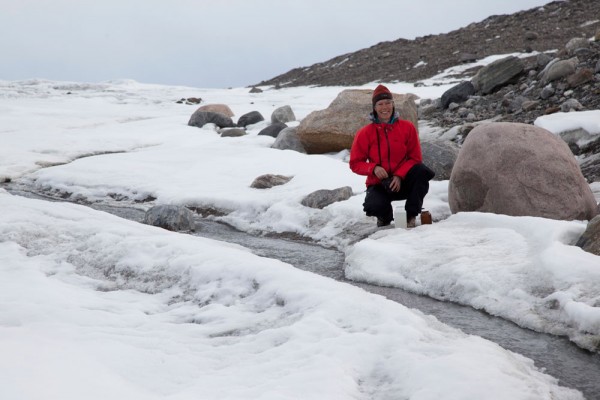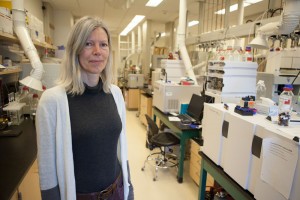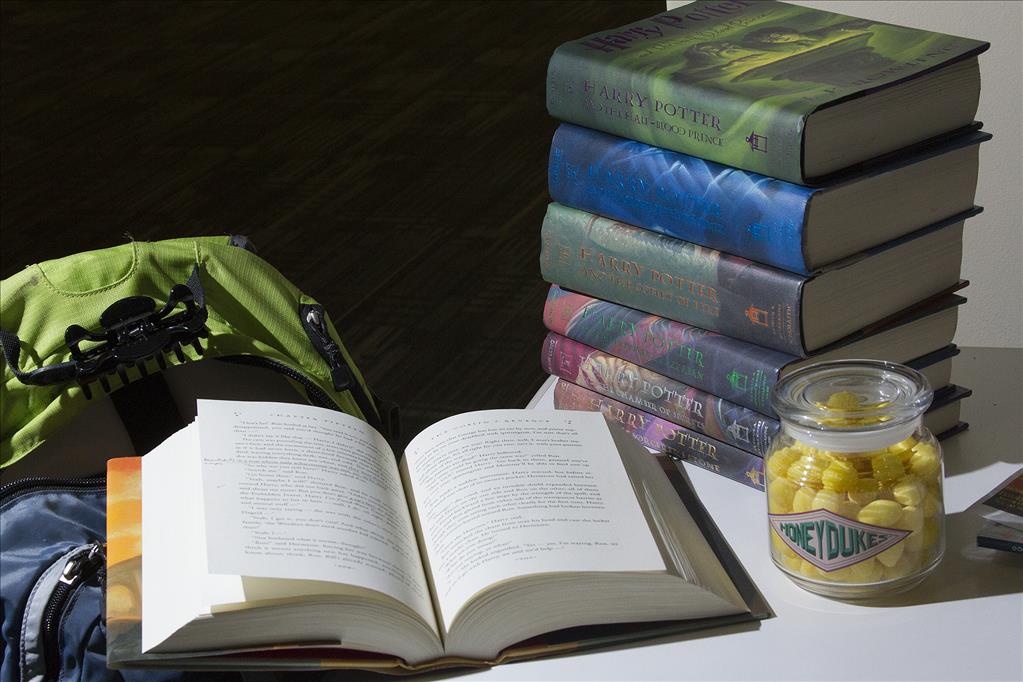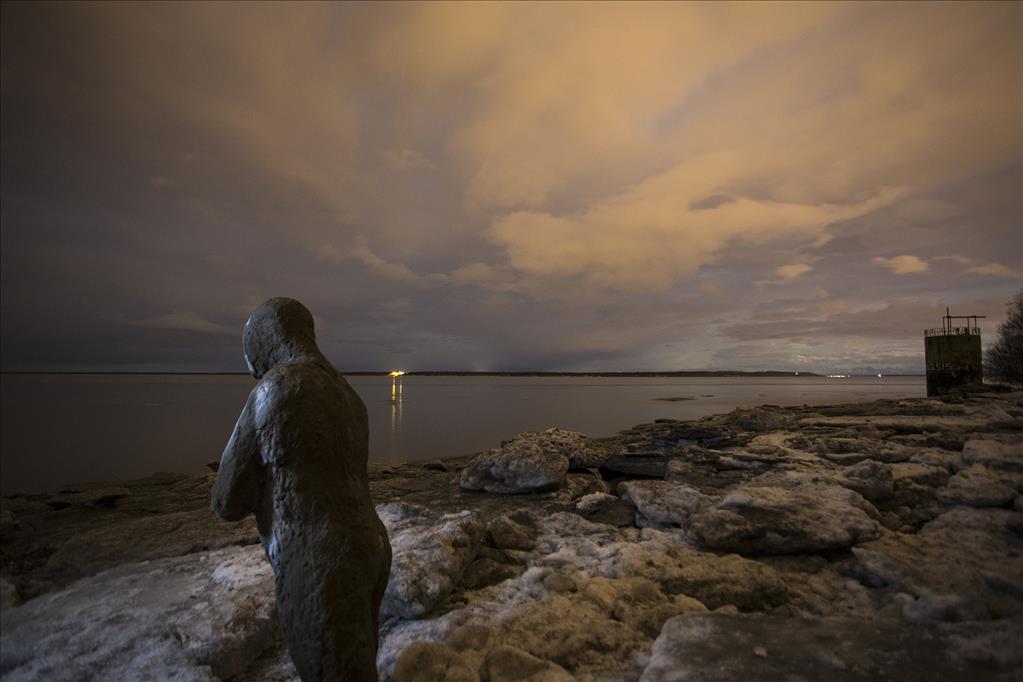Is toxic mercury flowing out of Alaska's melting glaciers?
by Kathleen McCoy |

UAA geochemist Birgit Hagedorn in Thule, Greenland. (Photo by Ronald Sletten, University of Washington, used with permission of Birgit Hagedorn)
UAA geochemist Birgit Hagedorn is as comfortable talking with eighth graders at Romig Middle School about glaciers as she is managing the complexities of UAA's ASET Lab.
ASET stands for Applied Science Engineering Technology Lab and it's where biologists, ecologists and environmental scientists tackle some of the most vexing health, safety and climate change issues facing Alaska.
Hagedorn uses the lab herself. In 2014, she finished a three-year collaboration with researchers from the University of Washington and Louisiana State University, studying how melting glaciers provide micronutrients and carbon to the ocean. She was looking specifically at iron in Greenland's Ice Sheet.
The news is good. "Iron increases phytoplankton growth, a valuable nutrient for everything living in the ocean, and that also consumes carbon dioxide," Hagedorn said. "So, some positive feedback to climate change."
A UAA graduate student working with Hagedorn, Kyla Choquette, earned her master's thesis by demonstrating that iron levels in outflows varied between northern and southern sites. That's an important nuance; scientists trying to determine future iron flows to the ocean can err in their calculations by assuming they are always consistent, Hagedorn said. "She shed light on that complexity with her work."
Hagedorn, who earned her doctorate in geochemistry at the University of Heidelberg in Germany, has worked at UAA since 2006. Lately, she's been teaming up with microbiologists to better understand how microbes work at the interlayer of rock and ice beneath a glacier to contribute to the release of elements like iron.
These single-cell organisms, so tiny that millions fit into the eye of a needle, are the oldest life form on earth. But no one knows which microbes are doing the work, or even how they accomplish it. Hagedorn wants to find out.

Hagedorn in the ASET Lab that she manages and uses to research microbial action at the interlayer between rocks and glacial ice. (Photo by Phil Hall/University of Alaska Anchorage)
She and a collaborator wrote another National Science Foundation grant to study microorganisms in Alaska glaciers. The proposal got positive feedback from reviewers, but they wanted more preliminary data before committing.
So Hagedorn and collaborating biologist Fred Rainey applied and won an Innovate grant, $10,000 in research seed money from UAA, so she could enrich her NSF application with data from Alaska's glaciers.
This go-round, she's specifically looking at mercury. Recent studies report increasing mercury levels, including the most toxic form, methylmercury, in Arctic and Subarctic fish and mammals. This, despite the fact that atmospheric mercury levels are more stable, thanks to cleaner standards and practices at many coal plants around the world.
Her question is this: Is there a microbial mechanism beneath the glacier-working between ice and bedrock-that could actually methylate, or transform, naturally occurring mercury into toxic methylmercury?
Furthermore, are legacy contaminants, deposited over time from decades of industrialization, frozen into the glacial ice? Are these contaminants being released now, through melting, to make contact with those microbes beneath the glacier?
Hagedorn and a handful of undergraduate students will be trekking around Matanuska Glacier gathering outflow samples as soon as they can get there. She's hopeful they also may find their way to other glaciers in the Alaska Range, such as Ruth, Redoubt and Spencer glaciers, for samples from there. And she's already collaborating with scientists at UAS, who've analyzed mercury in their nearby glaciers and have committed to sharing outflow samples for the microbial study.
All this work is to find out if there is methylmercury in Alaska glacial outflow. This would prove that microbes are present to methylate, or transform, mercury found in the bedrock or mercury that is seeping down through the glacier from earlier, once frozen, deposits.
"I think it is important for us to show that this is not just one glacier, so we'll have a series of investigations and broaden it to other Alaska glaciers," Hagedorn said. This work is aimed at bolstering her NSF proposal in July.
Meantime, back to those eighth graders. I asked Hagedorn how she got to know them.
She said it happened a few years ago, when she was invited to give a talk to school kids during a "Macro to Micro" workshop funded by the National Science Foundation. She chose her Greenland research, and had an audience filled with Romig eighth graders and a teacher. The talk seemed to click with them, she said, and teachers have invited back to the school every year since, something she really enjoys.
"All those eighth graders at Romig," she said, smiling, "they know this story well!"
A version of this story by Kathleen McCoy appeared in the Alaska Dispatch News on Sunday, March 29, 2015.
 "Is toxic mercury flowing out of Alaska's melting glaciers?" is licensed under a Creative Commons Attribution-NonCommercial 4.0 International License.
"Is toxic mercury flowing out of Alaska's melting glaciers?" is licensed under a Creative Commons Attribution-NonCommercial 4.0 International License.














